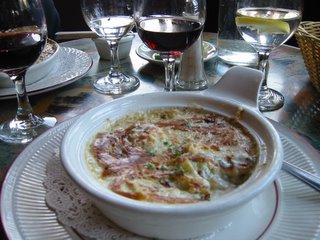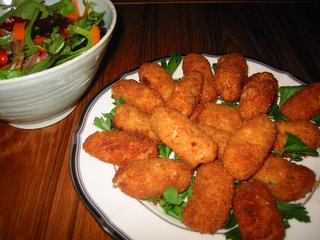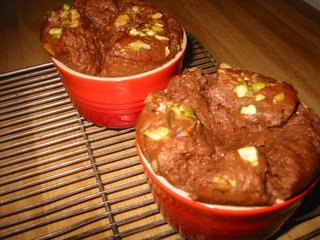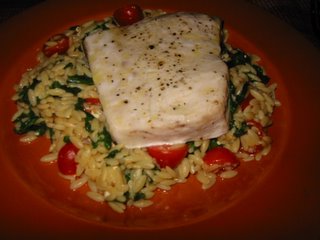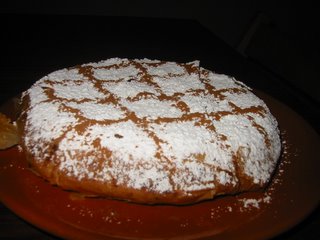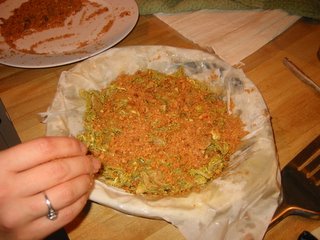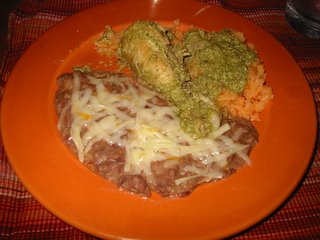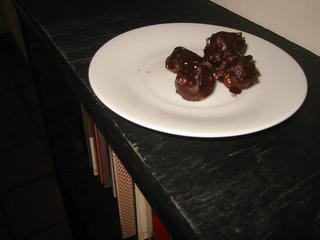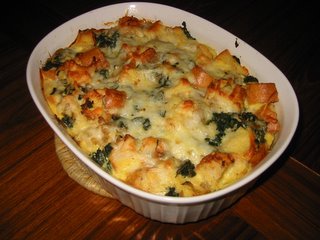
Last weekend, we went to see the mildly amusing new comedy The Family Stone. In one scene, Sarah Jessica Parker's character was fussily making a strata (one that later ends up on the floor and all over Ms. Parker), and I remembered that strata was something I enjoy that I haven't had for a couple years. Was it one of those trendy dishes that people used to make, or has it always been in style and I just forgot about it? I decided to make one-- my parents had arrived, I'm off from work, and it seemed like a festive thing for the holidays. Strata is a lot like quiche-- you can improvise a great deal around a basic recipe. You could add mushrooms or zucchini to your saute, or use different cheeses. I like it that this version is meatless, and also that it involves spinach, so at least you're doing something to offset all the cheese. It sits in the refrigerator all night, absorbing the eggs and milk, and when you bake it, it puffs up delightfully. I adapted this from a Gourmet recipe to make it, to my mind, slightly healthier.
Spinach & Asiago Cheese Strata
1 10 ounce package frozen chopped spinach
1 1/2 cups finely chopped onion
1 Tblsp. butter
1 Tblsp. olive oil
1 tsp. salt
1/2 tsp. black pepper
1/4 tsp. freshly ground nutmeg
7-8 cups French bread, chopped into 1 inch cubes
1 1/2 cups coarsely grated asiago cheese (or use whatever cheese you want)
3/4 cup finely grated pecorino romano (or parmesan)
2 1/4 cups lowfat milk
4 eggs
1 cup Egg Beaters egg substitute
2 Tblsp. Dijon mustard
Cook spinach in microwave for five minutes, squeeze out as much water as possible. Finely chop spinach. Meanwhile, saute onions in butter & olive oil mixture until soft. Add 1/2 tsp. of the salt salt, 1/4 of the pepper, and all the nutmeg. Add spinach, mix well, and remove from heat.
Spray a 3 quart gratin dish or casserole with cooking spray; layer 1/3 of the bread cubes on the bottom. (They may not cover the entire area.) Top with 1/3 of spinach mixture. Sprinkle with 1/3 of each cheese. (Strata! The word calls to mind rock layers, and geologic time.) Repeat layers two more times, ending with cheese.
In a separate bowl, whisk together eggs, egg substitute, milk, mustard, and remaining 1/2 tsp. salt and 1/4 tsp. pepper. Pour over strata evenly, cover with plastic wrap, refrigerate overnight.
The next morning, remove strata from your refrigerator thirty minutes before you plan to start cooking it. Preheat oven to 350. After 30 minutes, place strata in middle of oven and bake for 45-55 minutes. Mine looked ready at 45 but was still wet in the center, so 55 was more like it. Serves about 8 people, or 6 very hungry ones...


